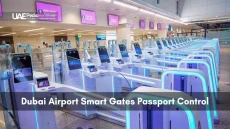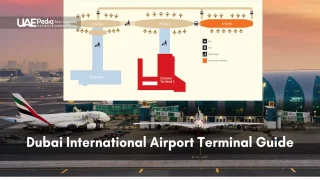What does it take to create an aviation hub ready for 260 million travelers annually? Dubai answers with a $35-billion blueprint that reimagines air travel’s future. Announced by Sheikh Mohammed bin Rashid Al Maktoum, this megaproject at Dubai World Central will soon become the planet’s busiest crossroads for people and cargo.
The new facility replaces Dubai International Airport, currently ranked among the world’s top three for passenger traffic. Five parallel runways and 400+ aircraft gates will sprawl across 27 square miles – roughly the size of Manhattan. Imagine seamless connections where today’s busiest terminals feel like small-town train stations.
This isn’t just about size. The design focuses on generational impact, anticipating needs through 2120. As Dubai’s aviation sector evolves, the project positions the city as a nexus for global trade routes and smart logistics. Sustainability features will likely set new industry standards, though specifics remain under wraps.
Here’s what you’ll discover in our deep dive:
- How phase-by-phase construction balances ambition with operational reality
- The hidden tech ensuring seamless transitions between current and future airports
- Why this development could reshape global flight patterns and cargo networks
Overview of Al Maktoum International Airport Expansion
Picture a city where runways stretch like desert highways and terminals hum with AI-powered efficiency. That’s the vision taking shape at Dubai World Central, where leaders first sketched this aviation revolution over coffee in 2010. Fast-forward to 2014, when Sheikh Mohammed bin Rashid Al Maktoum stamped approval on what’s now becoming Earth’s most ambitious transit hub.
Decoding the Masterplan
The numbers dazzle: a 1.7-mile concourse longer than Central Park’s reservoir loop, gates for 400+ aircraft, and tech that’ll make security lines feel like VIP check-ins. But this isn’t just about scale—it’s about smart growth. Phase one targets 150 million travelers yearly by 2034, nearly triple Dubai International’s current traffic.
| Feature | Dubai International (2023) | Al Maktoum Phase 1 (2034) |
|---|---|---|
| Annual Capacity | 89 million | 150 million |
| Runways | 2 | 5 |
| Tech Integration | Biometric boarding | AI-driven baggage systems |
Terminal capacity expansion to 150 million represents a 68.5% increase over current global maximums, redefining scale parameters for airport design Ref.: “Airports Council International (2023). World Airport Traffic Forecasts 2023-2040. ACI Global Reports.”
City-Shaping Ambitions
Sheikh Ahmed bin Saeed puts it simply: “This isn’t an airport—it’s the heart of a new metropolis.” The expansion anchors Dubai South, a 145 km² urban zone blending homes, logistics parks, and innovation hubs. Think of it as Manhattan meets Silicon Valley—with jet fuel.
Smart sensors will track everything from luggage to lounge temps, while solar farms power 60% of operations. For travelers, it means breezing through a terminal that learns your preferences—before you even land.
Key Developments in al maktoum international airport expansion plans
Imagine stepping into a terminal where your luggage arrives before you do. That’s the reality taking shape at Dubai World Central, where engineers are rewriting airport rulebooks. Let’s unpack how this desert megaproject plans to handle 260 million travelers without breaking a sweat.
Building in Waves
Phase one kicks off with a concourse stretching longer than 12 football fields – matching the combined size of Dubai International’s existing terminals. Underground baggage networks will whisk suitcases to planes while you sip karak chai. By 2034, five solar-powered runways and AI-coordinated gates aim to triple current capacity.
Tech That Thinks Ahead
The facility’s brain? A central AI monitoring 50,000+ sensors. Automated people movers glide between terminals, and recycled water cools glass-domed lounges. “We’re not just constructing buildings – we’re coding efficiency into every beam,” shares a Dubai Aviation Engineering Projects lead.
Space to Breathe (and Connect)
Future phases add rail links tying directly to Abu Dhabi and a metro line snaking through terminals. The final layout gives each passenger 60% more personal space than today’s crowded hubs. Think zen gardens between gates, not crammed waiting areas.
- Phase 1 (2024-2034): West Terminal, 3 new runways, AI baggage systems
- Phase 2 (2035-2050): 2 additional concourses, hyperloop connections
- Sustainability wins: Zero-waste kitchens, 40% energy from onsite solar
Comparative Analysis: Dubai vs. Global Airport Expansion Trends
Gulf nations are racing to build aviation empires – but not all runways lead to the same destination. Let’s unpack how Dubai’s strategy compares to regional rivals and global giants.
Capacity Showdown
Saudi Arabia’s King Salman International aims for 120 million travelers yearly – impressive, but still 30 million short of Dubai’s first-phase target. Qatar’s Hamad International recently hit 58 million, while Dubai’s current hub serves 89 million. The numbers reveal a clear leader.
| Project | Peak Capacity | Runways | Tech Focus |
|---|---|---|---|
| Dubai World Central | 260 million | 5 | AI logistics |
| King Salman (Saudi) | 120 million | 6 | Modular design |
| Hamad (Qatar) | 70 million | 2 | Luxury amenities |
Winning the Connectivity Game
While NEOM’s vertical airport targets futuristic transit, Dubai bets on phased growth. “We’re building capacity that adapts as demand shifts,” notes a Dubai construction expert. This approach lets them scale operations without empty terminals.
Regional passenger traffic could hit 500 million annually by 2040. Dubai’s five-runway system positions it to capture 40% of that growth. Compare that to Singapore’s Changi (4 runways) or Istanbul’s new hub (3 runways) – the math favors desert visionaries.
Smart logistics and solar-powered terminals give Dubai an edge in sustainability too. While others build bigger, this city builds smarter – ensuring every gate serves tomorrow’s traveler, not just today’s.
Final Insights on the Future of Al Maktoum International Airport Expansion
When cities dream big, they build transit hubs that rewrite rulebooks. The phased growth at Dubai World Central isn’t just about moving people – it’s about reimagining how we connect continents. By 2050, this desert marvel could handle twice the annual traffic of London Heathrow and JFK combined.
Sheikh Mohammed’s team predicts seamless transitions: Emirates Airlines plans gradual shifts from the current hub starting late 2030s. Imagine walking through terminals where AI adjusts lighting to match flight times, and solar farms hum beneath taxiing jets. “We’re crafting an ecosystem, not just runways,” the ruler noted during a recent site tour.
For travelers, this means breezing through 400+ aircraft gates with zero queue anxiety. Sustainability shines too – recycled water cools lounges, while hyperloop links slash ground transit times. Analysts see Dubai World Central anchoring 30% of global east-west cargo routes by 2045.
As the city evolves, so does its skyline. This project fuels Dubai South’s rise as a smart metropolis blending homes, tech parks, and logistics magic. Ready to watch history take flight? Keep your boarding pass handy – the next update might just change how you see air travel forever.
The emirate’s visionaries, led by Sheikh Mohammed bin Rashid Al Maktoum, aim to future-proof aviation growth. With Dubai International (DXB) nearing capacity, this expansion positions Dubai World Central (DWC) as the world’s largest hub—handling 260 million passengers annually while supporting smart city development around the site.
Initial terminal operations are slated for 2030, with five parallel runways and 400 aircraft gates. Full completion targets 2050, but Dubai Aviation Engineering Projects often accelerates timelines—we’ll update you as cranes rise over the 70 sq km site!
DXB remains the primary hub until 2030+. Gradually, airlines will shift operations to DWC’s futuristic terminals. Think seamless transitions—like upgrading from a trusted sedan to a hyperloop while keeping your favorite routes intact.
It’s not just about size (though 5x larger than DXB is jaw-dropping). The project integrates AI baggage systems, solar farms, and direct metro links to Expo City Dubai. Imagine checking in via facial recognition while your suitcase zips autonomously to a A380-1000!
Not yet—but the nearby Dubai Airshow offers previews of next-gen aviation tech. Once open, expect observation decks overlooking the 24/7 runway ballet. Pro tip: Book a desert safari nearby to spot the skyline transforming!
Absolutely. Dubai South’s “aerotropolis” around DWC is booming—think smart warehouses, eco-residences, and hotels shaped like falcon wings. Investors eyeing logistics hubs or Airbnb-friendly pads near the site should watch this airspace.


















